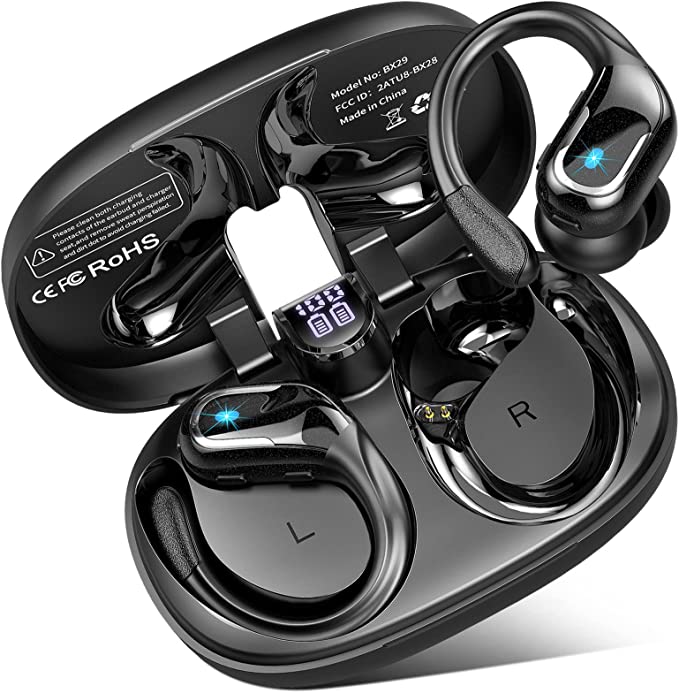In today’s world, they’re almost extensions of ourselves. Tucked into our ears during commutes, workouts, or just navigating the day, wireless earbuds have become ubiquitous companions. Yet, faced with a sea of options and a blizzard of technical jargon, how do we really know what makes one pair different from another? What truly shapes that seamless stream of music or that clear phone call?
Let’s pull back the curtain. Think of this not as a typical review, but as an exploration, a peek under the hood guided by an audio technology enthusiast – me. We’ll use the described features of a specific model, the CASCHO BX17 wireless earbuds (based on readily available product information), as our map. Our goal? To understand the fascinating interplay of technology, design, and user experience that defines modern wireless audio, moving beyond simple spec points to grasp the why behind the what.

The Invisible Tether: Untangling Bluetooth 5.3
The magic of wireless audio hinges on Bluetooth, that invisible tether connecting your earbuds to your device. It’s a technology that’s come a long way from its early days as a simple cable replacement. The BX17 earbuds, according to their description, employ Bluetooth 5.3. But what does that number really signify?
Think of Bluetooth standards like generations of wireless communication, each building upon the last. Bluetooth 5.3, as defined by the Bluetooth Special Interest Group (SIG), offers a toolkit of potential enhancements over its predecessors. These can include improvements in connection reliability, power efficiency, and data transmission capabilities. The specifications for the BX17 claim it leverages this, suggesting “2X fast transfer speed (75% higher than the previous generation)” and a “more stable connection.”
While the real-world experience always depends on both the earbuds and the connected device, a more advanced Bluetooth version like 5.3 fundamentally aims to provide a more robust connection. Imagine the wireless connection as a highway; newer standards often offer more lanes or smarter traffic management. For you, this translates to the potential for fewer annoying audio dropouts, especially in crowded wireless environments. It might also mean better synchronization between audio and video – that frustrating lip-sync lag becoming less common. The claim of “almost no delay” points towards this goal.
Beyond stability, convenience is key. Features like “One Step Auto Connect,” where the BX17 earbuds reportedly pair automatically with the last known device simply by opening the case, are direct benefits of modern Bluetooth’s streamlined protocols. It’s these small refinements that remove friction from our daily interactions with technology.

The Endurance Equation: Powering Your Listening Marathon
There’s a unique modern anxiety associated with the dwindling battery icon on our devices. Wireless earbuds are no exception. Running out of juice mid-song or mid-call is universally frustrating. The BX17 specifications address this head-on with a bold claim: up to 60 hours of total playback time.
How is this marathon endurance achieved? It’s a two-part system. The earbuds themselves are stated to hold enough charge for about 10 hours of listening. But the real powerhouse is the charging case, described as carrying a 650mAh (milliampere-hour) battery. Think of mAh as the volume of the battery’s energy reservoir – like the size of a car’s fuel tank. A larger number means more stored energy.
This 650mAh case acts like a portable power bank specifically for the earbuds, capable of delivering approximately five full recharges before the case itself needs plugging in. This system dramatically extends the usable time away from a power outlet, turning hours into days for many users.
Perhaps one of the most user-friendly features described is the case’s LED Digital Display. This isn’t just a gimmick; it’s a practical tool against battery anxiety. The display reportedly shows the remaining percentage of the case’s charge (with each grid representing 25%, according to the description) and, crucially, the individual charge level of both the left and right earbuds when they are docked. No more guessing if you have enough power for the commute home – a quick glance provides the answer. This thoughtful detail, often praised in user feedback found on retail platforms, significantly enhances the everyday usability. Powering this entire system, like most modern portable gadgets, are Lithium Polymer (Li-Po) batteries, chosen for their ability to pack substantial energy into small, form-fitting shapes.
Crafting the Sound: Drivers, Graphene, and the Quest for Clarity
Ultimately, earbuds exist to deliver sound. This task falls to the ‘drivers’ – essentially miniature speakers, the tiny acoustic engines within each earpiece that convert electrical signals into the sound waves we perceive. The BX17 specifications mention 13.4mm drivers equipped with a “graphene diaphragm.”
Let’s break that down. The driver size, 13.4mm, is relatively large for an earbud, which can contribute to moving more air and potentially producing a fuller sound. The diaphragm is the vibrating membrane that actually creates the sound waves – think of it like the skin of a microscopic drum.
The material mentioned, graphene, is where material science meets audio. Graphene is a form of carbon renowned for being incredibly strong yet astonishingly lightweight and thin (just one atom thick!). In theory, a diaphragm made from such a material could be very advantageous: its lightness allows it to respond incredibly quickly and precisely to the audio signal, potentially leading to greater clarity and detail. Its stiffness helps it vibrate without deforming, which could minimize distortion, especially at higher volumes.
The manufacturer claims this results in “sufficiently strong bass and naturally connects to the mid and high frequencies.” It’s important to approach such claims with a bit of nuance. While graphene holds theoretical promise, its actual impact in consumer audio, especially in more budget-friendly segments, can be complex and sometimes debated. User feedback on the BX17, gleaned from the product page, often highlights excellent clarity and clear vocals, though perceptions of bass strength can vary – a common subjective aspect of audio. What’s clear is the intention behind using such materials: the ongoing engineering quest for better sound reproduction.
Of course, audio isn’t just about consumption. The built-in microphone is essential for phone calls and interacting with voice assistants. The BX17 description mentions “crystal clear calls,” signifying an effort to ensure voice pickup is adequate for communication, turning the earbuds into a versatile communication tool as well.

Built for Life’s Rhythm: Ergonomics and Resilience
Beyond sound and power, how earbuds feel and hold up to daily life is paramount. The BX17 employs an over-ear hook design, a specific ergonomic choice aimed squarely at stability. Why hooks? Basic physics. They distribute the earbud’s weight over a larger area of the ear and provide a secure anchor point above the ear canal. This makes them significantly less likely to dislodge during vigorous activities like running, jumping, or even just moving your head quickly, compared to designs relying solely on friction within the ear canal.
The materials chosen – described as soft silica gel for the hooks with a non-slip finish at the end – contribute to both comfort during extended wear and that crucial grip. User comments frequently echo the success of this design, particularly for those with smaller ears or who struggle to keep other earbud types in place during exercise.
Then there’s resilience. The BX17 carries an IPX7 waterproof rating. This code, defined by the International Electrotechnical Commission (IEC 60529), needs demystifying. ‘IP’ stands for Ingress Protection. The first digit (‘X’ in this case) relates to protection against solid particles (like dust); ‘X’ means it hasn’t been specifically tested or rated for this. The second digit, ‘7’, relates to liquid protection. A ‘7’ rating signifies that the device can withstand temporary immersion in water up to 1 meter deep for up to 30 minutes under specific laboratory conditions (usually fresh, still water).
What does this mean practically? It means the BX17 should comfortably handle sweat during intense workouts and shrug off getting caught in the rain. However, as the product’s own FAQ section rightly clarifies, IPX7 does not mean they are suitable for swimming (due to prolonged immersion, water pressure, and potentially chlorine/salt) or showering (where hot water, steam, and soap pressure exceed the testing parameters). Understanding these limits is key to ensuring longevity.
Finally, the choice of physical button controls over touch-sensitive surfaces is another deliberate design decision. While touch controls can feel sleek, buttons offer tactile feedback – you know you’ve pressed it. This can be particularly beneficial during exercise when fingers might be sweaty or when wearing gloves, reducing the chance of accidental track skips, volume changes, or call disconnections that can sometimes plague overly sensitive touch interfaces. It’s a trade-off favouring reliability in certain situations.
Your Audio, Your Way: Stereo Freedom and Mono Awareness
Modern true wireless earbuds, including the BX17 according to its description, offer flexibility in how you listen. You can use both earbuds together for a standard, immersive stereo sound experience. Alternatively, you can often use just one earbud – either the left or the right – independently in Mono mode.
This isn’t just a minor feature; it has real practical advantages. Mono mode is perfect for situations where you need to stay aware of your surroundings – perhaps listening to a podcast while cycling on a busy street, waiting for announcements at an airport, or keeping one ear open in an office environment. It also allows you to easily share your music or audio source with a friend, each taking one earbud. This adaptability enhances the earbuds’ utility across diverse scenarios.

The Sum of Its Parts: Balancing Act in Modern Audio Tech
Looking at the CASCHO BX17 through the lens of its described features reveals a microcosm of modern consumer audio engineering. It’s a balancing act. Technologies like Bluetooth 5.3 aim for robust connectivity. Thoughtful battery systems with high-capacity cases and clear displays tackle power anxiety. Material choices like graphene in drivers represent attempts to push sound quality forward within budget constraints. Ergonomic designs like ear hooks prioritize stability for active users, while IP ratings provide necessary resilience against the elements. Even control methods like buttons represent conscious trade-offs between sleekness and practical reliability.
No single product is perfect, especially in accessible price ranges where compromises are inevitable. But by understanding the science, the standards, and the design philosophies behind the features listed on a spec sheet, we can move beyond marketing buzzwords. We become more informed consumers, better equipped to appreciate the intricate engineering packed into these tiny devices and to choose the audio companions that truly fit the rhythm of our lives. The journey of wireless audio continues, constantly evolving to offer more performance, more convenience, and more freedom – one technological step at a time.




